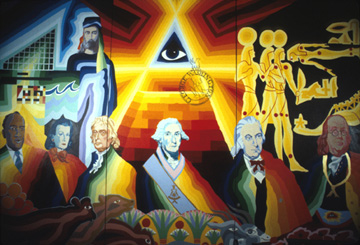
Segment from the 100 foot long mural painted by Dr. Bob Hieronimus in 1986
called "E Pluribus Unum." Located at the Lexington Market, downtown
Baltimore. A full-color booklet explaining the symbolism is available in the
Hieronimus & Co. Gift Shop.

Segment from the 100 foot long mural painted by Dr. Bob Hieronimus in 1986
called "E Pluribus Unum." Located at the Lexington Market, downtown
Baltimore. A full-color booklet explaining the symbolism is available in the
Hieronimus & Co. Gift Shop.
These days Robert "Dr. Bob" Hieronimus is probably best known as the host of 21st Century Radio on WCBM (AM 680) -- a sort of New Age gad-fly whose interests range from UFOs and astrology to environmentalism and rock'n'roll. But long before he took to the airwaves, Hieronimus gained local fame as the creator of colorful, cryptic murals, some of which have become Baltimore landmarks. As 1998 marks the 30th anniversary of Hieronimus' mural-painting career, the time seems right for a tour of his extant work.
We begin at Levering Hall on Johns Hopkins University's Homewood Campus. Upstairs, in the Office of Volunteer Services, behold "The Apocalypse," a 2,700-square-foot acrylic mural commissioned in 1968 by JHU's legendary activist/chaplain Chester Wickwire. "The Apocalypse" mixes politics with biblical prophecy: Miss Liberty sinks into the waves, an eagle is infected with corporate logos, a serpent spits fire. The style is often described as "psychedelic," but Hieronimus maintains that everything about the work is soberly symbolic. The dense mingling of ancient and modern icons sets the pattern for the murals that followed.
Next, chronologically, comes "America's Bicentennial, 1976-1996," painted in 1974 at Lafayette and St. Paul Streets. The imagery here is less threatening than in the JHU mural, and slightly less cryptic: An allegorical figure of Columbia leans into a bald eagle; the Beatles' Yellow Submarine (a recurring Hieronimus image) is moored to Baltimore's Battle Monument. Surveying the scene is the eye-on-pyramid symbol familiar from the U.S. dollar bill, a motif that is virtually the artist's logo. The original palette was bold blue, green, red, and gold; these have faded over time to gentle pastels.
In the heart of Hampden, the "Congressional Medal of Honor" mural (1975) overlooks the corner of 36th Street and Roland Avenue. An eagle dangles banners bearing the names of two Hampdenites who earned the Medal of Honor in World War I. Hieronimus recalls this as a difficult assignment due to community restrictions and "the worst condition wall I ever painted on." Ironically, it might be his most publicly visible painting.
The least-visible Hieronimus mural covers one side of an 18-inch-wide keyhole alley at 838 Tyson St. This privately commissioned painting is a mystical celebration of Elisha Tyson, the abolitionist hero and city father for whom the street is named. Not content with mere history, Hieronimus worked in a unicorn, the Greek god Pan, and the by-then-obligatory yellow sub and pyramid. From the street you have to peer through a steel grate to get a glimpse.
In his 1976 "War Memorial" mural, Hieronimus continued in a historical vein with scenes of Baltimore's harbor in 1752, 1838, and 1857. In the foreground are several Lords Baltimore and, incongruously, George Washington crossing the Delaware. In the pastel harbor floats the early submarine Argonaut, and a certain other sub. As a pastiche of fact and fantasy, the mural is a good match for the eclectic Deco-Roman style of the Memorial itself.
Crossing the harbor to the South Baltimore peninsula, we come to the "All-American City" mural (1977) at Fort Avenue and Lawrence Street, originally conceived as a sort of gateway to the Locust Point area. Immigrants, many of whom arrived via Locust Point, dominate the foreground; the 1977 city skyline spreads across the top. Unfortunately this huge image is now obscured by a Blockbuster video store, and two decades of sunlight have reduced its original pastel colors to near-subliminal tones.
Next-to-last stop: Lexington Market. Enter the Market East building at Eutaw and Lexington Streets, hang a right, proceed to the counters of Muhly's Bakery and Park's Fried Chicken, and look up at "E Pluribus Unum" (pictured above), completed in 1986. This might be Hieronimus' masterpiece, incorporating all of his favorite themes, icons, and color codes, plus portraits of more than 30 people ranging from Ralph Waldo Emerson to burlesque queen Blaze Starr. It was also the last public mural for which Hieronimus strained his back muscles. He is now essentially retired from mural making, although he still gets involved when recruited. "A Little Help from Our Friends" (1996) at 3333 Greenmount Ave., winner of City Paper's "Best Mural" nod last year (Best of Baltimore, 9/17/97), was designed and largely funded by Hieronimus but executed by painters Katie Butler, Lyle Kissack, and Gerald Ross. It shows Gandhi, Martin Luther King Jr., Bob Marley, Bob Dylan and others who, like Hieronimus, started out as radicals and became institutions.
[Click here for a photo of "A Little Help From Our Friends"]
Hieronimus & Co., Inc., P.O. Box 648, Owings Mills, MD 21117 USA
Voice Mail: (410) 356-4852 Fax: (410) 356-6229